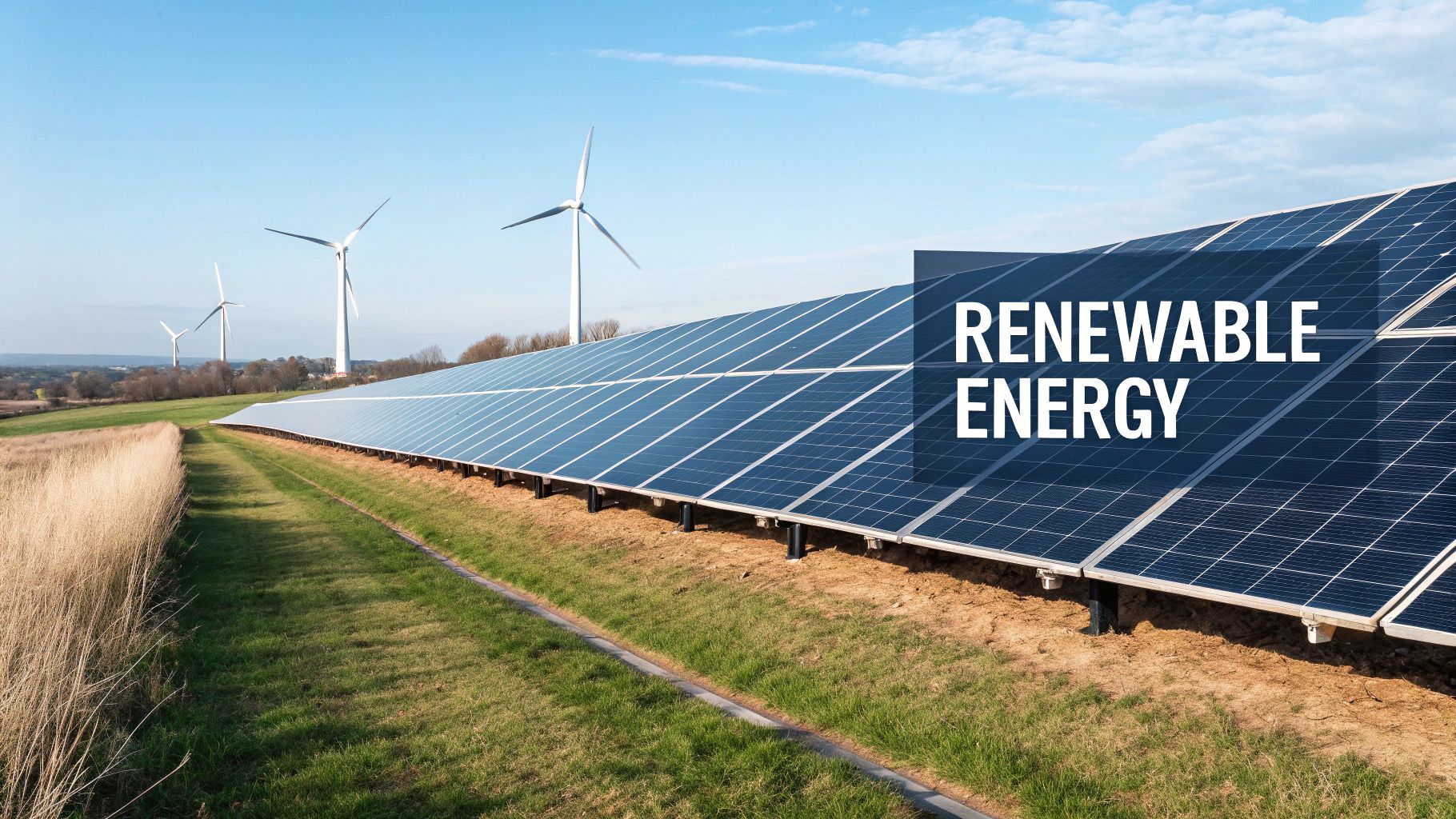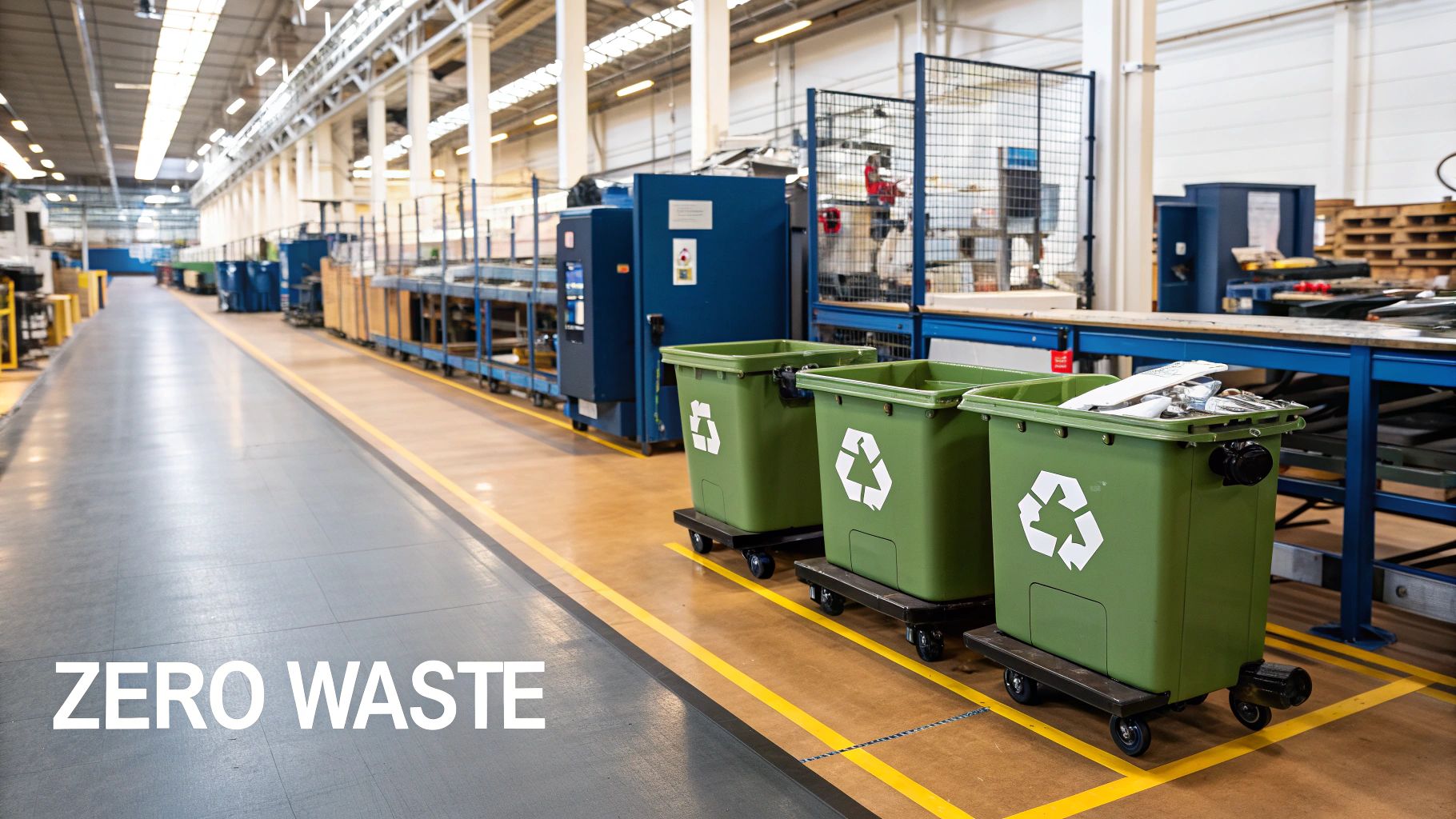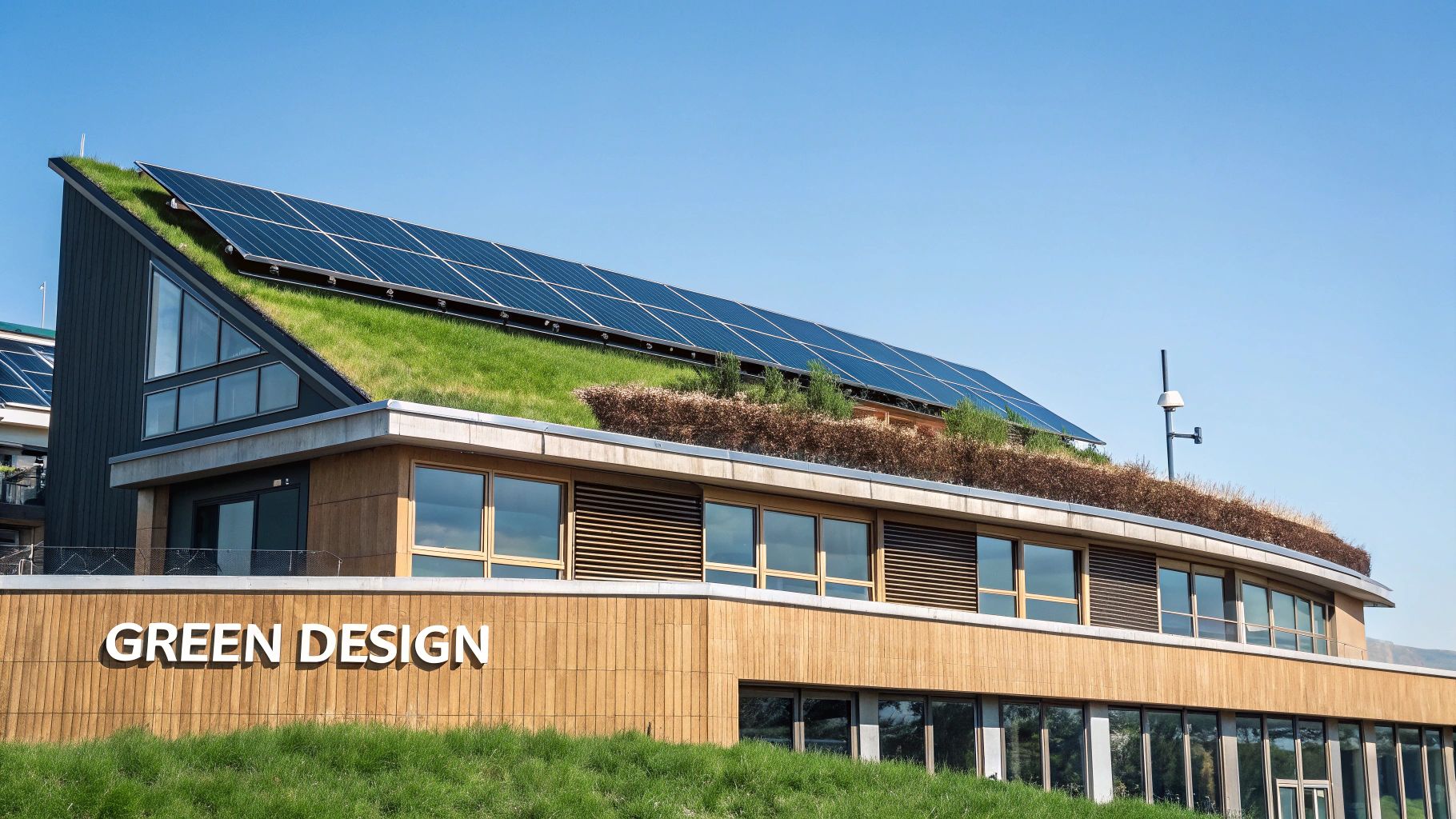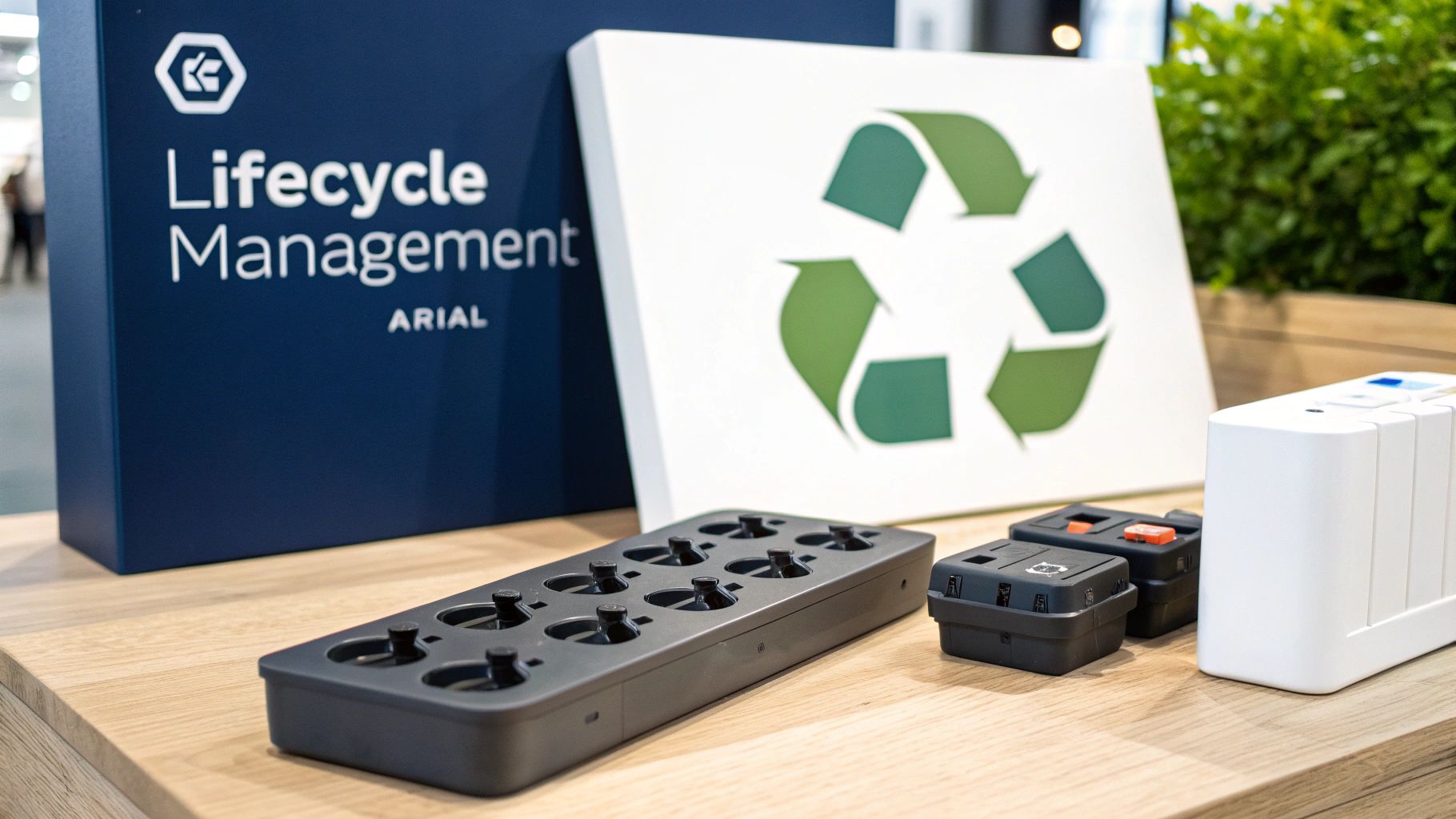Going Green: Why Sustainability Matters
The focus on sustainability has become essential for modern business success. For too long, companies prioritized profits while neglecting their impact on the environment and society. Now, a major shift is occurring - business leaders and consumers alike recognize that financial success and environmental responsibility work together. Understanding sustainable practices isn't optional anymore - it's crucial for entrepreneurs, investors, and anyone building for the long term.
This shift began with the environmental movement of the 20th century, sparked by works like Rachel Carson's "Silent Spring" which highlighted our limited natural resources. Now, frameworks like the triple bottom line (focusing on people, planet, and profit) and circular economy models are changing how businesses operate and invest. The most effective sustainable approaches create systems that reduce environmental damage while supporting social and economic progress - delivering benefits across all areas.
The following guide outlines ten key business practices that support both planetary and financial health. Whether you're starting a new venture, seeking investment opportunities, or developing professional skills, these strategies can help create lasting value. Learn how adopting sustainable practices can strengthen your brand, improve financial performance, and contribute to a thriving environment. The evidence shows that businesses can succeed while being a force for positive change.
1. Renewable Energy Adoption

Adopting renewable energy is one of the most impactful steps a business can take toward sustainability. By switching from fossil fuels to clean energy sources like solar, wind, and hydroelectric power, companies can dramatically reduce their environmental impact while saving money in the long run. This shift also resonates strongly with eco-conscious customers.
Key Ways to Implement Renewables:
Here are the main approaches businesses can take:
- On-site installations: Add solar panels to your building or install wind turbines on your property to generate your own clean energy
- Power Purchase Agreements (PPAs): Partner with renewable energy providers who own and operate the facilities while you purchase the electricity at set rates
- Renewable Energy Certificates (RECs): Buy certificates representing clean energy generation to offset your regular power usage
- Smart energy systems: Use advanced monitoring and management tools to optimize renewable energy usage
Companies Leading the Way:
Several major brands have shown what's possible:
- Google runs on 100% renewable energy worldwide
- IKEA owns wind farms and solar installations across its operations
- Apple powers its offices and data centers with solar energy
Market Growth:
More businesses are adopting renewable energy each year as costs drop and climate awareness grows. Groups like RE100 bring together companies committed to 100% clean power, while innovators continue advancing the technology.
Benefits and Challenges:
The key advantages include:
- Lower emissions: Much smaller carbon footprint
- Cost savings: Protection from rising fossil fuel prices
- Energy security: Less dependence on external providers
- Better reputation: Appeal to environmentally-conscious consumers
Common obstacles to consider:
- Upfront costs: Significant initial investment required
- Weather factors: Solar and wind output varies with conditions
- Storage needs: Challenges in saving excess energy
- Facility updates: May need infrastructure changes
Tips for Getting Started:
- Evaluate usage: Review your current energy consumption patterns
- Mix energy sources: Combine different renewables for reliability
- Research incentives: Look into tax breaks and rebates
- Take it step-by-step: Begin with smaller projects before scaling up
Renewable energy represents both an environmental imperative and a smart business move. Companies that make the switch can cut costs, strengthen their brand, and help create a more sustainable future. For business leaders focused on long-term success, renewable energy offers a path to combine profitability with positive impact.
2. Zero Waste Manufacturing

Manufacturing without waste represents a major change in how companies think about production. Rather than just focusing on output, businesses now put sustainability at the heart of their operations. Companies strive for closed-loop systems by finding ways to recycle, reuse, or convert waste materials into new products or energy sources.
The magic happens through circular production systems. Instead of taking resources, making products, and throwing away waste, these systems work like nature - continuously cycling materials. Waste becomes a valuable input for other processes. This includes careful sorting of materials, recycling programs, using byproducts, and composting organic waste.
More companies are embracing zero waste as consumers demand eco-friendly products and regulations get stricter. Smart businesses realize waste equals lost money and resources. Some companies lead by example - Subaru operates zero-landfill plants, while Toyota runs comprehensive waste reduction programs. The flooring maker Interface shows what's possible with their circular manufacturing approach.
Key benefits of zero waste manufacturing:
- Lower Costs: Reduced expenses for waste disposal, landfill fees, and hazardous materials
- Better Resource Use: Making the most of materials saves money and preserves raw resources
- Environmental Benefits: Less waste means a smaller environmental impact and fewer pollutants
- Strong Brand Image: Customers prefer companies that care about sustainability
Common challenges to consider:
- Equipment Costs: New machinery and infrastructure needed to minimize waste requires investment
- Staff Training: Teams need education on new waste management methods and procedures
- Complex Planning: Setting up circular systems takes careful coordination across departments
- Short-term Slowdown: Productivity may dip temporarily as workers adjust to new processes
Tips for getting started:
- Study Your Waste: Analyze what waste you generate to find key areas for improvement
- Train Your Team: Help employees understand zero waste goals and their role in success
- Find Recycling Partners: Build relationships with local recycling facilities
- Start Small: Begin with realistic targets and gradually increase goals as systems improve
Zero waste manufacturing points the way toward a better business model that helps both profits and the planet. For entrepreneurs and investors focused on long-term success, this approach offers a chance to build companies that thrive while protecting the environment. The path may require work, but the rewards make it worthwhile.
The Power of Sustainable Supply Chain Management
Supply chain management that prioritizes sustainability has become essential for modern business success. It covers every step from sourcing raw materials to delivering finished products, with a focus on protecting the environment, ensuring fair labor practices, and maintaining business viability. For entrepreneurs and investors focused on growth, this presents major opportunities to build value while making a positive impact.
A sustainable supply chain addresses critical gaps that many companies overlook. Even businesses with strong internal sustainability practices can undermine their efforts through problematic supplier relationships. True sustainability requires alignment across the entire network of partners.
Key Elements of Sustainable Supply Chain Management:
- Local Sourcing: Working with nearby suppliers reduces transportation emissions and strengthens local economies
- Supplier Assessment: Evaluating environmental and social performance metrics helps ensure partners meet sustainability standards
- Green Logistics: Using efficient routes, eco-friendly vehicles, and smart packaging minimizes environmental impact
- Ethical Practices: Maintaining fair pricing, safe conditions, and human rights throughout the supply chain
Benefits:
- Lower Emissions: Optimized transportation and resource use reduces carbon footprint
- Risk Protection: Diverse, sustainable suppliers provide stability against disruptions
- Stronger Brand: Growing consumer focus on ethics and environment builds trust
- Cost Savings: While setup requires investment, efficiency gains drive long-term returns
Challenges:
- Higher Costs: Sustainable materials and fair labor often cost more
- Complex Management: Coordinating multiple sustainable partners takes effort
- Limited Options: Finding suppliers meeting criteria can be difficult in some areas
- Measurement Issues: Tracking sustainability across the chain presents challenges
Success Stories:
- Patagonia provides full supply chain transparency to customers
- Unilever set ambitious targets for sustainable sourcing and social impact
- Nike launched "Move to Zero" to eliminate waste and use sustainable materials
Implementation Tips:
- Map your complete supply chain from start to finish
- Create clear sustainability requirements for suppliers
- Use digital tools to monitor performance
- Conduct regular supplier sustainability audits
The growing focus on Environmental, Social and Governance (ESG) factors makes sustainable supply chain management essential for long-term business success. By building sustainability into supply chain operations, companies can protect their brand, manage risks, and contribute to positive change.
For entrepreneurs and investors seeking impactful opportunities, mastering sustainable supply chain practices provides a path to build value while advancing important environmental and social goals.
Learn more about sustainable business practices at The Covered Call
4. Green Building Design

Green building design represents a smart approach to creating spaces that work better for people and the planet. The focus is on making buildings that use fewer resources, cost less to operate, and provide healthier environments for occupants. For businesses looking to make an impact, green building offers clear financial benefits while supporting environmental goals.
The Basics of Green Building
At its foundation, green building considers the complete lifecycle of a structure - from initial planning through eventual demolition. Each phase is carefully designed to minimize waste and environmental impact. The results are impressive: lower operating costs, reduced energy use, and properties that hold their value better over time.
Essential Features
- Smart Energy Systems: Modern HVAC equipment, intelligent lighting, and energy-saving appliances that significantly cut power usage
- Earth-Friendly Materials: Using recycled steel, sustainably harvested wood, and local materials to reduce transportation needs
- Water-Saving Solutions: Installing efficient fixtures, capturing rainwater, and choosing plants that need less water
- Natural Light Design: Making the most of daylight to reduce electricity needs and create more pleasant spaces
Real Success Stories
- The Edge in Amsterdam: Shows what's possible with smart technology, featuring an advanced power grid and underground thermal storage
- Apple Park in Cupertino: Runs entirely on clean energy with one of the world's largest solar installations
- Bullitt Center in Seattle: Sets new standards by generating its own power and processing its waste on-site
Industry Progress
Green building gained momentum when certification systems like LEED and BREEAM established clear standards for sustainable construction. Leading architects have helped bring these practices into mainstream building design.
Practical Steps to Get Started
- Start with an energy assessment to find the best opportunities for improvement
- Choose materials that minimize environmental impact
- Design spaces to use natural light effectively
- Add water-saving features throughout the building
- Work with certified green building experts for best results
Benefits and Challenges
Advantages:
- Reduced operating expenses
- Better workplace environment
- Smaller environmental footprint
- Enhanced property value
Challenges:
- Initial construction costs
- Complex certification requirements
- Material availability issues
- Special maintenance needs
Green building design makes good business sense by combining smart resource use with better building performance. It helps companies save money while showing real commitment to environmental responsibility. For businesses planning ahead, green building is becoming an essential strategy rather than just a nice-to-have option.
5. Employee Sustainability Programs
Creating meaningful environmental impact requires active participation from your entire workforce. Employee sustainability programs transform team members into environmental champions while building a stronger company culture focused on responsible business practices.
Why Employee Engagement Matters:
Experience shows that successful environmental initiatives need broad support across all levels of an organization. Programs designed without employee input often fail to gain momentum. By giving employees ownership over sustainability efforts, companies unlock creative solutions and create lasting positive change.
Features of Effective Programs:
Sustainability Training: Give employees practical knowledge about environmental concepts, company goals, and how they can make a difference. This can include interactive workshops, e-learning modules, and expert presentations.
Green Incentive Programs: Reward sustainable choices with meaningful benefits. This might include carpool rewards, discounts on eco-friendly products, or recognition for waste reduction champions.
Employee Volunteer Programs: Create opportunities to support local environmental causes through park cleanups, tree planting, and conservation projects. These activities build team spirit while benefiting communities.
Green Commuting Initiatives: Support eco-friendly transportation through public transit subsidies, bike storage, and carpool parking spots.
Real-World Examples:
Patagonia: Offers paid time for environmental activism and empowers employees to support local green initiatives.
Interface: Engages employees in waste reduction and circular economy projects, delivering both cost savings and environmental wins.
Pros:
- Increased Employee Engagement: Staff feel valued when they help shape sustainability efforts, boosting morale.
- Better Environmental Results: Engaged teams achieve real reductions in waste, energy use, and resource consumption.
- Stronger Company Culture: Shared environmental goals unite employees and attract mission-driven talent.
- Fresh Solutions: Employee participation sparks creative approaches to sustainability challenges.
Cons:
- Program Costs: Training, incentives, and resources require upfront investment.
- Time Requirements: Program development and management needs dedicated staff time.
- Measurement Challenges: Quantifying engagement impact takes careful tracking.
- Engagement Fluctuations: Maintaining long-term participation requires ongoing effort.
Tips for Implementation:
- Start Small: Test ideas with pilot programs before full rollout.
- Clear Communication: Keep everyone updated on progress and participation opportunities.
- Track and Share Wins: Document results and celebrate team achievements.
- Provide Tools: Give employees what they need to participate effectively.
Employee sustainability programs strengthen both environmental performance and workplace culture. They represent a smart investment in your people and our planet while building business value for the long term.
6. Product Lifecycle Management
Product Lifecycle Management (PLM) focuses on managing a product's environmental impact from raw materials through disposal or recycling. This practice helps build businesses that use resources wisely and minimize waste. For business owners and investors, PLM offers clear opportunities to create lasting value.

Understanding and Application
Key elements of PLM include:
- Smart design: Using recycled materials, reducing energy use, and making products easy to take apart and recycle
- Sustainable materials: Choosing materials that can be recycled when the product is done
- Modular parts: Building products with replaceable components for easy fixes and updates
- Product returns: Setting up systems to collect and recycle used items
More customers now want eco-friendly products, while rules about waste and resources are getting stricter. This makes PLM essential for businesses looking ahead.
Real-World Success Stories
Here are companies showing how PLM works:
- Philips: Offers lighting systems that customers can lease, making upgrades and reuse simple
- Dell: Uses recycled plastic from old computers to make new ones
- H&M: Takes old clothes from customers and turns them into new items
How to Get Started
- Check your impact: Look at how your product affects the environment at each stage
- Design smart: Use sustainable materials and make recycling easy
- Work with suppliers: Choose partners who care about sustainability
- Take products back: Give customers reasons to return used items
- Be open: Share what you're doing to build trust with customers
Benefits and Challenges
Benefits:
- Less waste in landfills
- Lower costs for materials
- Loyal customers who care about the environment
- Meeting regulations about environmental protection
Challenges:
- Complex design requirements
- Higher startup costs for some green practices
- Market readiness varies by region
- System needs for recycling programs
Why PLM Matters
PLM helps businesses thrive while protecting our environment. It creates opportunities to save money, build customer loyalty, and stay ahead of regulations. By cutting waste and using resources wisely, companies can boost profits while helping the planet. For entrepreneurs and investors, PLM is both responsible and smart business.
7. Water Conservation
Water has become scarce, making smart water management essential for businesses. Companies that prioritize water conservation not only help the environment but also boost their profitability and operational efficiency.
Effective business water conservation involves monitoring consumption patterns and implementing systems to reduce waste. The rising costs of water and tighter regulations have made this a key focus area for forward-thinking companies.
Key Features of Business Water Conservation:
- Water Recycling Systems: Treat and reuse wastewater for irrigation and cooling systems
- Efficient Fixtures: Install low-flow toilets, faucets, and other water-saving equipment
- Rainwater Harvesting: Collect rainwater for non-drinking uses
- Process Optimization: Modify manufacturing and cleaning procedures to minimize water use
Pros:
- Lower Bills: Reduced water consumption means direct cost savings
- Supply Security: Less dependence on municipal water sources
- Environmental Impact: Protection of local water resources and ecosystems
- Legal Compliance: Meeting water regulations while building brand trust
Cons:
- Upfront Costs: New systems require initial investment
- Setup Time: Installing conservation measures takes planning
- Skills Needed: Staff must learn proper system operation
- Regular Upkeep: Ongoing maintenance ensures optimal performance
Real-World Examples:
- Coca-Cola: Comprehensive water program focused on efficient bottling and community projects. Learn more about Coca-Cola's water initiatives
- Intel: Extensive water recycling in manufacturing facilities
- PepsiCo: Water efficiency program targeting production and supply chain
Practical Tips for Implementation:
- Conduct a Water Audit: Map out current usage patterns
- Set Clear Goals: Define specific water reduction targets
- Train Staff: Get employees involved in conservation
- Track Progress: Monitor usage and adjust methods as needed
- Find Incentives: Look for utility rebates on water-saving equipment
Why Water Conservation Matters:
Smart water management helps businesses control costs while securing long-term access to this vital resource. For business owners aged 35-75, water conservation offers concrete benefits: reduced operating expenses, better risk management, and enhanced company reputation. By making water efficiency a priority now, companies position themselves for success as water becomes increasingly precious.
8. Sustainable Packaging
The push for environmentally responsible packaging has become essential for modern businesses. More than just protecting products, packaging now needs to consider its full environmental impact - from production through disposal. For business owners, this presents both a challenge and an opportunity to reduce costs while attracting eco-conscious customers.
Consumer awareness about plastic pollution and environmental damage has dramatically increased demand for green alternatives. People now actively look for products with minimal environmental impact, making sustainable packaging a major factor in their buying choices. This consumer shift, along with new environmental regulations, is pushing companies to adopt earth-friendly packaging solutions.
Key Features of Sustainable Packaging:
- Natural Materials: Options like cornstarch bioplastics, mushroom-based materials, and seaweed packaging that naturally decompose
- Smart Design: Using less material through efficient design and removing unnecessary packaging layers
- Recycled Components: Using post-consumer and post-industrial recycled materials to reduce virgin material needs
- Reusable Options: Creating multi-use packaging systems like refillable containers to support circular business models
Benefits:
- Less Waste: Significant reduction in material going to landfills
- Lower Shipping Costs: Lighter packaging means reduced transportation expenses
- Customer Loyalty: Resonates with environmentally conscious buyers
- Market Advantage: Helps distinguish your brand through environmental commitment
Challenges:
- Material Expenses: Eco-friendly options often cost more initially, though prices are decreasing
- Durability Concerns: Some sustainable materials may not protect products as well as conventional options
- Supply Chain Changes: May need to adjust existing supplier relationships and processes
- Storage Requirements: Special conditions may be needed to maintain material integrity
Success Stories:
- Loop: Offers products in durable, reusable containers that customers return for cleaning and refilling
- Amazon's Frustration-Free Program: Focuses on minimal, recyclable packaging to improve customer experience
- Lush: Sells many products without packaging, eliminating waste entirely
Implementation Guide:
- Review Current Packaging: Evaluate what you use now and identify improvement areas
- Research Materials: Test eco-friendly options to find the right fit
- Improve Design: Remove excess materials and streamline packaging
- Find Green Suppliers: Work with vendors who prioritize sustainability
- Tell Your Story: Share your environmental efforts with customers
For entrepreneurs and business leaders, sustainable packaging offers real potential. It meets growing consumer demand for environmental responsibility while potentially reducing long-term costs. Making this change benefits both the planet and your business results, making it a crucial part of modern business practices.
9. Carbon Offsetting
Reducing carbon emissions to zero should be every business's goal. However, some carbon emissions are often unavoidable when running a business. Here's where carbon offsetting helps by investing in environmental initiatives that lower greenhouse gas emissions in one place to make up for emissions your business produces elsewhere. Think of it as evening out the scales - for every ton of CO2 you emit, you help reduce or remove an equal amount through supported projects.
The rise of carbon offsetting tracks with growing climate awareness as companies looked for ways to minimize their environmental impact. It's become a practical solution for addressing emissions that can't be eliminated through direct operational changes, especially as more customers and investors prioritize environmental responsibility.
How Carbon Offsetting Works:
Several key approaches enable carbon offsetting:
- Carbon Credit Purchasing: Companies can buy verified carbon credits, with each credit equal to one metric ton of CO2 reduced or removed. Credits come from projects like reforestation and renewable energy.
- Reforestation Projects: New trees naturally absorb CO2. Supporting tree planting directly helps capture carbon while restoring ecosystems.
- Renewable Energy Investment: Funding solar and wind projects helps replace fossil fuel power with clean energy.
- Emission Reduction Programs: Supporting efforts to cut emissions from sources like landfills or factories contributes to offsetting goals.
Pros of Carbon Offsetting:
- Quick Results: Offsetting can neutralize emissions rapidly
- Options: Companies can select offset projects matching their goals
- Project Support: Offset investments fund critical environmental work
- Brand Benefits: Showing carbon neutrality commitment can appeal to eco-conscious customers
Cons of Carbon Offsetting:
- Not the Main Solution: Offsetting shouldn't replace direct emission cuts. It supplements other changes.
- Verification Issues: Checking offset project effectiveness requires careful review
- Cost Changes: Carbon credit prices can vary, affecting budgets
- Project Risks: Long-term success of some projects faces threats like fires or disease
Real-World Examples:
- Microsoft: Aims to be carbon negative by 2030 through major investments in carbon removal and offsetting
- Google: Heavily invests in offset programs to neutralize operational emissions
- Lyft: Makes rides carbon neutral by offsetting vehicle emissions through verified projects
Practical Tips for Implementation:
- Calculate your carbon footprint: Get accurate emission data to plan offsetting needs
- Choose proven providers: Select certified projects meeting recognized standards like Gold Standard
- Focus on quality: Look for projects with clear environmental and social benefits
- Be transparent: Share your offsetting approach and supported projects with stakeholders
- Keep improving: Review and update your strategy based on results and best practices
Carbon offsetting deserves consideration because it gives businesses a practical way to handle unavoidable emissions while working toward sustainability. For entrepreneurs, understanding this tool can help attract environmentally-minded investors and customers. While not perfect, responsible carbon offsetting forms a key part of a complete sustainability plan.
10. Sustainable Transportation
Companies can dramatically reduce their environmental footprint and operating costs by making smarter choices about how they move people and goods. This shift toward greener transportation makes both environmental and business sense.
Growing concerns over pollution and rising fuel prices have pushed sustainable transportation to the top of many corporate agendas. Consumers increasingly support companies that demonstrate real commitment to reducing emissions and congestion in their communities.
Key Features of Sustainable Transportation:
- Electric Vehicle Fleets: Converting to EVs eliminates tailpipe emissions from delivery and service vehicles
- Route Optimization: Using smart software to plan the most efficient routes saves fuel and reduces miles driven
- Alternative Fuels: Options like biodiesel, CNG, and hydrogen cells offer cleaner alternatives to gas and diesel
- Rail and Water Transport: Moving freight by train or ship instead of trucks can slash carbon emissions
Benefits:
- Smaller Carbon Footprint: Less pollution means cleaner air and a healthier environment
- Reduced Fuel Costs: EVs and alternative fuels often cost less to operate than gas/diesel vehicles
- Better Operations: Smart routing leads to less wasted time and resources
- Community Relations: Less traffic and noise helps build goodwill with local residents
Challenges:
- Upfront Costs: New vehicles and equipment require significant initial investment
- Infrastructure Gaps: EV charging and alternative fuel stations may be limited
- Range Issues: EVs may not match traditional vehicles' driving range
- Learning Curve: Staff need training on new vehicles and systems
Real Company Examples:
- Amazon: Committed to electric delivery vans as part of their zero-carbon plan
- DHL: Uses alternative fuels and optimized routes in their "GoGreen" program
- FedEx: Testing various alternative fuels and electric vehicles
Tips for Getting Started:
- Start Small: Test sustainable options with pilot programs before scaling up
- Mix Solutions: Combine EVs, alternative fuels, and smart routing for best results
- Use Technology: Route planning software and tracking systems improve efficiency
- Phase In Changes: Make the transition gradually to minimize disruption
Smart transportation choices can help companies cut costs while showing real environmental leadership. This creates opportunities for businesses to improve their bottom line while doing good for the planet.
Sustainable Business Practices: A Comparative Analysis of 10 Key Strategies
| Method | Difficulty | Time Required | Results | Best For | Key Benefit |
|---|---|---|---|---|---|
| Renewable Energy Adoption | 🔄 High (Capital intensive) | ⚡ Long (Phased implementation) | 📊 Long-term savings & sustainability | Large enterprises | ⭐ Energy independence & carbon reduction |
| Zero Waste Manufacturing | 🔄 Medium (Process redesign) | ⚡ Moderate (Gradual changes) | 📊 Waste reduction & cost efficiency | Manufacturers | ⭐ Resource efficiency |
| Sustainable Supply Chain Management | 🔄 High (Complex coordination) | ⚡ Moderate (Ongoing monitoring) | 📊 Enhanced brand & risk management | Global supply chain companies | ⭐ Integrated sustainable operations |
| Green Building Design | 🔄 High (Certification process) | ⚡ Long (Construction cycle) | 📊 Energy efficiency & increased property value | Developers & corporations | ⭐ Lower operating costs |
| Employee Sustainability Programs | 🔄 Low (Simple setup) | ⚡ Fast (Quick rollout) | 📊 Improved culture & employee innovation | All organizations | ⭐ Increased employee engagement |
| Product Lifecycle Management | 🔄 Medium (Design integration) | ⚡ Moderate (Lifecycle planning) | 📊 Waste reduction & customer loyalty | Consumer product companies | ⭐ Regulatory compliance & sustainability |
| Water Conservation | 🔄 Medium (System upgrades) | ⚡ Moderate (Implementation phase) | 📊 Cost savings & resource security | Water-intensive operations | ⭐ Reduced utility costs |
| Sustainable Packaging | 🔄 Low (Material switch) | ⚡ Fast (Quick adoption) | 📊 Brand differentiation & waste reduction | Consumer goods businesses | ⭐ Eco-friendly branding |
| Carbon Offsetting | 🔄 Low (Investment-based) | ⚡ Fast (Immediate impact) | 📊 Quick carbon reduction | Carbon-intensive businesses | ⭐ Flexible emissions management |
| Sustainable Transportation | 🔄 High (Fleet conversion) | ⚡ Moderate (Gradual shift) | 📊 Improved efficiency & lower emissions | Logistics & transport sectors | ⭐ Reduced operational emissions |
Building a Greener Future, Together
Running a sustainable business requires dedication across multiple areas – from renewable energy and zero-waste manufacturing to green building design and ethical supply chains. Success depends on carefully managing resources through practices like water conservation, sustainable packaging, carbon reduction, and smarter transportation. To get started, assess your current operations and identify where you can make meaningful changes, whether through new technologies, process improvements, or employee training.
The push for sustainability continues to gain momentum each year. Businesses need to stay current with emerging solutions, changing regulations, and new industry standards. Notable developments include increased supply chain transparency, circular economy models, and more rigorous sustainability reporting requirements. While challenging to implement, these changes create opportunities for forward-thinking companies.
Key Takeaways:
- Success now requires strong environmental practices across operations
- Integrating sustainability should be a core business priority
- Continuous improvement and adaptation are essential
- Benefits include lower costs, better reputation, and competitive advantage
Want to build a business aligned with your values while achieving financial independence? It takes strategic thinking and the courage to pursue unconventional paths. The Covered Call Podcast offers guidance through interviews with accomplished entrepreneurs and thought leaders. Hosts Jason Nutter and Lovis Kauf speak with experts like Luke Gromen, Rick Rule, Doug Casey, Peter Alexander and Adrian Day about creating meaningful success. Get valuable insights for your journey at The Covered Call Podcast.

